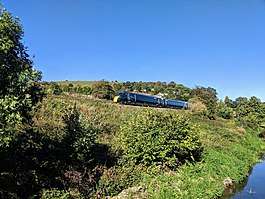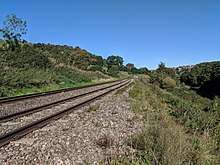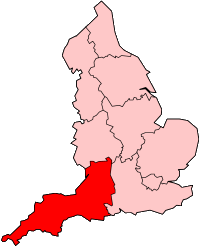Golden Valley line
The Golden Valley line is the popular name given to the railway line between Swindon and Gloucester or Cheltenham Spa in England.[1]
| Golden Valley line | |
|---|---|
 Class 800 on the Golden Valley line | |
| Overview | |
| Type | Heavy rail |
| System | National Rail |
| Status | Operational |
| Locale | Gloucestershire Wiltshire South West England |
| Operation | |
| Owner | Network Rail |
| Operator(s) | Great Western Railway |
| Technical | |
| Track gauge | 1,435 mm (4 ft 8 1⁄2 in) standard gauge |
| Golden Valley line |
|---|
The line was originally built as the Cheltenham and Great Western Union Railway in the 1840s. It was opened between Swindon and Kemble, along with a branch line to Cirencester, in 1841. It took a further four years before the remainder of the line, including the tunnel at Sapperton, was completed.
The line diverges from the Great Western Main Line at Swindon. After passing through the Sapperton tunnel and down the Golden Valley to Stroud, it joins the Bristol Temple Meads to Birmingham New Street main line at Standish Junction, just north of Stonehouse.
Origin of name
The "Golden Valley" is the name given to part of the valley of the River Frome between Chalford and Stroud, which the railway line follows for part of its route. It is said that the name was coined by Queen Alexandra, wife of King Edward VII, while travelling on a train along the route in June 1909.[1] The name has since become associated with the entire line from Swindon to Gloucester and Cheltenham, as these are the extents of the shortest train services along the line.
Places served
The towns served by the route are:
- Swindon
- Kemble
- Stroud
- Stonehouse
- Gloucester (through trains must reverse, or omit calling here)
- Cheltenham
The other intermediate stations and halts were closed to passengers on 2 November 1964.
Kemble station was a junction for two branch lines, serving Cirencester and Tetbury. Both branches closed to passengers on 6 April 1964.
Train services
Passenger services between Paddington and Cheltenham are operated by Great Western Railway. Services are approximately hourly. There are limited services between Swindon and Cheltenham Spa as well as on Mondays to Saturdays.
Electrification proposal
In 1977 the Parliamentary Select Committee on Nationalised Industries recommended considering electrification of more of Britain's rail network, and by 1979 BR presented a range of options to do so by 2000.[2] Options included electrifying numerous former Great Western routes including the Golden Valley line.[3] Under the 1979–90 Conservative governments that succeeded the 1976–79 Labour government the proposal was not implemented. As of 2016 there are no plans to electrify the line.
Reinstatement of second track

The line had originally been built as double track, but as a cost saving measure it was reduced to single track between Swindon and Kemble in 1968. It was intended that the whole of the line between Swindon and Standish Junction would be single track, with passing places at Kemble and Sapperton, but protests caused British Rail to abandon the project after reaching Kemble.
Network Rail proposed to reinstate the second track in September 2008, then September 2009, but the plans were referred to the Office of Rail Regulation. Despite protests by local MPs,[4] the ORR made a preliminary decision that the project would not be included in the 2009–2014 High Level Output Specification plan for new rail infrastructure.[5] In the 2011 Budget the Government announced that funding for the redoubling was to be provided, with works reported to be completed by Spring 2014[6] and then delayed until August 2014.[7][8]
Initial work involved slewing the single track, as it had been moved to the centre of the trackbed during the singling works. This was followed by excavation and clearance work, then finally installation of the new track. Level crossing works were also undertaken. The line was officially reopened by Anne, Princess Royal in October 2014.[9]
The redoubling was an important step in the 21st Century upgrade of the Great Western Main Line, as it provides a diversionary route for trains between London and Cardiff to use while the Severn Tunnel is closed or during electrification works between Swindon and Severn Tunnel Junction.[9]
See also
- Cheltenham and Great Western Union Railway – fuller details of the earlier stations on this line
- Thames and Severn Canal – runs alongside the line and can be seen from the train, particularly between Stroud and Kemble.
References
- [https://www.globalrailwayreview.com/article/26100/a-history-of-the-golden-valley-line/ A History of the Golden Valley Line, Global Railway Review
- Anonymous 1979, pp. 0–2.
- Anonymous 1979, p. 8.
- A copy of the debate is at https://www.theyworkforyou.com/debates/?id=2008-06-30a.703.0&m=1494
- "Extra railway line hopes dashed". BBC News. 30 October 2008. Retrieved 16 November 2008.
- "Chancellor approves Kemble to Swindon railway upgrade". BBC News. 23 March 2011. Retrieved 24 March 2011.
- "Swindon to Kemble railway line re-doubling delayed". BBC News. 7 February 2014. Retrieved 12 July 2014.
- "£45m rail doubling from Kemble completed". Wiltshire Gazette & Herald. 27 August 2014. Retrieved 27 August 2014.
- "Redoubling Swindon to Kemble Railway line". Premier Construction News. 17 October 2014. Retrieved 26 December 2018.
Sources
- Anonymous (Winter 1979). Railway Electrification. British Railways Board (Central Publicity Unit). pp. 0–2, 8.
